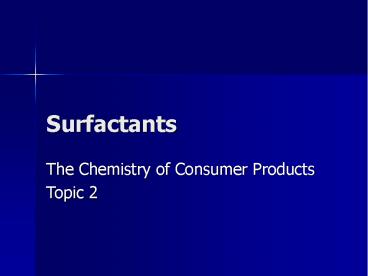Surfactants - PowerPoint PPT Presentation
Title:
Surfactants
Description:
Polar group contains O, S, P, or N. Non-polar group contains C, H. Amphophiles ... Surfactant molecules tend to adsorb to the surface of oil droplets. ... – PowerPoint PPT presentation
Number of Views:584
Avg rating:3.0/5.0
Title: Surfactants
1
Surfactants
- The Chemistry of Consumer Products
- Topic 2
2
Amphophiles
- Greek roots
- Amphi double from both sides
- Filos friend
- Ampophilic - two parts
- Polar group contains O, S, P, or N
- Non-polar group contains C, H
3
Amphophiles
- Hydrophilic or hydrophile
- Likes water
- Hydrophobe or lipophile
- Fears water or likes grease
4
Amphophiles
- Not at ease in any solvent
- Migrate to surfaces or interfaces
- Surface boundary between a condensed and gas
phase - Interface boundary between two condensed phases
5
Surfactant
- Short for
- Surface Active Agent
- Properties
- Lower surface tension
- Wetting agent
- Emulsifier
- Foaming agent
- others
6
Surfactant types
- Anionic
- Nonionic
- Cationic
- Amphoteric / zwitterionic
7
Anionic Surfactants
- Dissociate in water to give an amphophilic anion
and acation (generally Na, or K)
Sodium Dodecyl Sulfate
8
Anionic surfactants
- Most common type
- Examples
- Alkylbenzene sulfonates (detergents)
- Fatty acid soaps
- Laury sulfate (foaming agent)
- Di-alkyl sulfo succinate (wetting agent)
- Lignosulfanates (dispersants)
9
Nonionic Surfactants
- Do not dissociate in water
An alcohol ethoxylate and an alkylphenol
ethoxylate. The poly(ethylene oxide) chain forms
the water soluble surfactant "head".
alkyl polyglycosides contain one or more sugar
groups
10
Nonionic Surfactants
- Second largest classification
- Most have a hydrophilic group comprise of a
polyethylene glycol chain produced by the
condensation of ethylene oxide - Sugar based head groups are also used low
toxicity
11
Cationic Surfactants
- Dissociate in water to give an amphophilic cation
and an anion usually a halogen
Fatty amine salts were the first style of
cationic surfactant
The development of alkyl pyridinium and
quaternary ammonium salts provided excellent
surfactants that could be used over a vast range
of conditions
12
Cationic Surfactants
- Generally more expensive than anionics
- Used to target negatively charged substrates
13
Amphoteric / zwitterionic Surfactants
- A zwitterionic surfactant has both an anion and a
cation in one molecule chemically joined
together. Zwitterionic surfactants are also
called amphoteric surfactants as they often
comprise a base coupled to an acid.
Three zwitterionic surfactants an ammonium
carboxylate, an ammonium sulfate and an amine
oxide
14
Hybrid Surfactants
- combines a nonionic surfactant with an anionic
head group. - improves the behavior of the surfactants in hard
water. - increases the range of temperatures over which
the nonionic surfactants are soluble.
Sodium laureth sulfate
15
Saponification
- The saponification reaction is the hydrolysis of
fatty esters. The saponification reaction
typically refers to the reaction that is carried
out by a strong base. Historically, this was done
with potash (potassium hydroxide) rather than
sodium hydroxide, although nowadays we can obtain
sodium hydroxide from the hydrolysis of seawater.
16
Properties of Solutions
- Adsorption
- Surface tension reduction
- Self assembly
17
Adsorption
- Adsorption is the tendency for a surfactant
molecule to collect at an interface. (Adsorption
is very different to absorption - don't get them
confused!)
18
Adsorption
Surfactant molecules tend to adsorb to the
surface of oil droplets. The hydrophilic heads
stick out into the water phase, while the
hydrophobic tails happily stick into the oil
phase.
19
Reduction in surface tension
20
Self Assembly
- Self-assembly is the tendency for surfactant
molecules to organize themselves into extended
structures in water. This includes the formation
of micelles, bilayers and liquid crystals. These
structures are formed when the hydrophobic tails
of the surfactants cluster together, forming
small aggregates such as micelles, or large layer
structures (bilayers) which are similar to a cell
wall.
21
Self assembly
- Surfactants can aggregate to form micelles.
- There is usually between a few dozen to a couple
of hundred surfactant molecules in a micelle - Surfactants also aggregate to form extended
structures in water, such as surfactant bilayer,
or rods
22
Micelle Formation
Micelles will begin to form when the
concentration of the surfactant exceeds a limit
known as the critical micelle concentration.
23
Detergency

